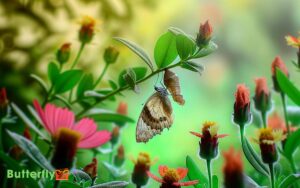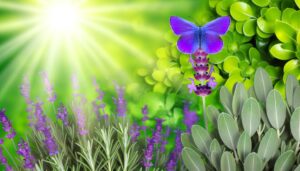When Do Butterflies Come Out in Your Garden?
Butterflies typically emerge during the spring, timed with environmental cues such as rising temperatures, which generally range between 15°C to 25°C, and increasing daylight hours. The actual emergence depends on species-specific life cycles, regional climatic conditions, and local microclimates.
For instance, species like the Mourning Cloak and Eastern Comma appear by late March in response to these changes. Seasonal shifts align butterfly activity with ideal conditions for nectar availability and mating.
Additionally, understanding these emergence patterns is vital for predicting population dynamics influenced by climate change. For a more detailed exploration of these fascinating phenomena, continue on.
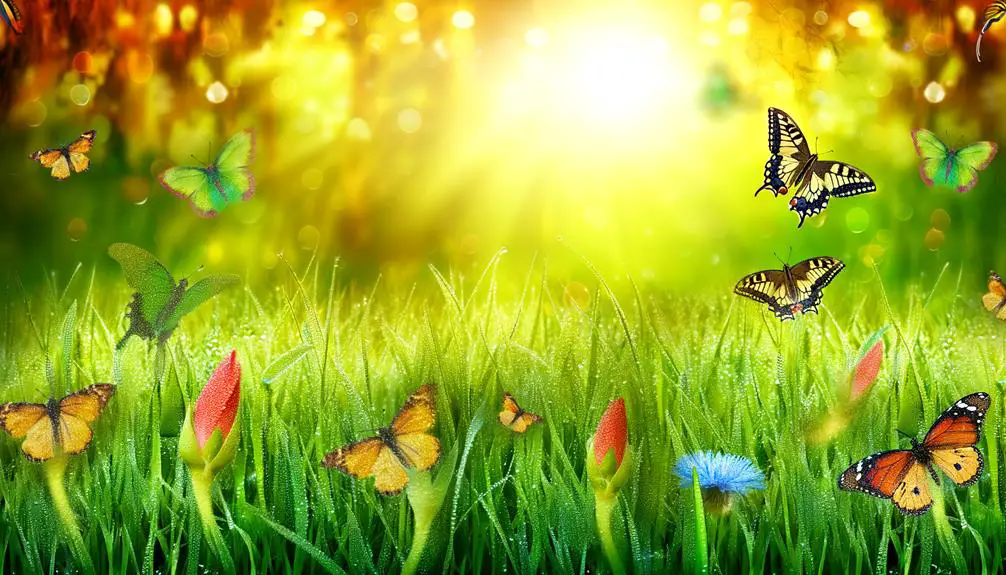
Key Takeaways
- Butterflies typically emerge in spring, triggered by rising temperatures and longer daylight.
- Early species like Mourning Cloak and Eastern Comma appear by late March.
- Temperature thresholds for emergence vary by species, generally between 15°C to 25°C.
- Fall signals decreased activity, with many species preparing for overwintering or migration.
Lifecycle of Butterflies
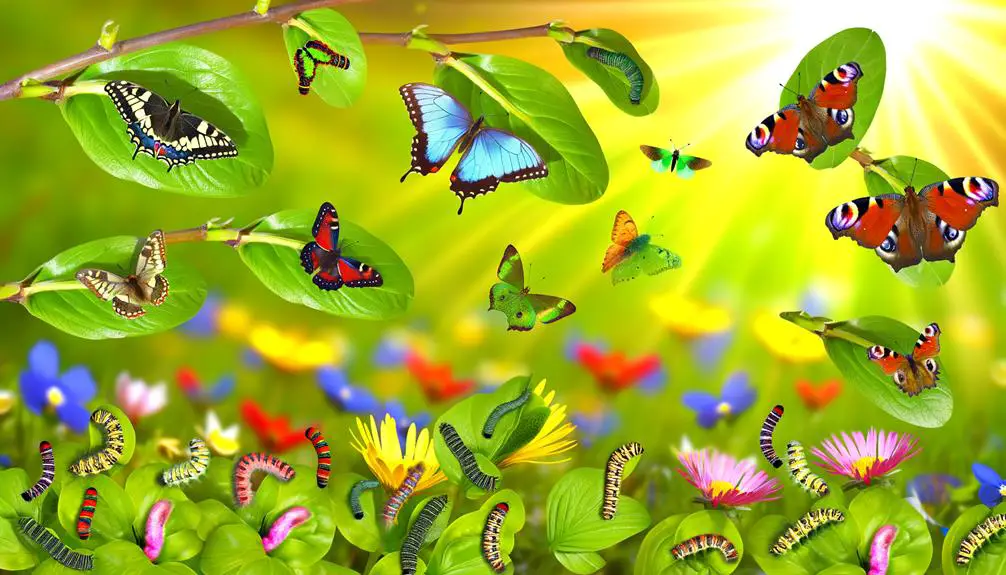
The lifecycle of butterflies encompasses four distinct stages: egg, larva (caterpillar), pupa (chrysalis), and adult butterfly, each characterized by unique physiological changes and developmental milestones.
Beginning as eggs, often laid on host plants, the embryos develop within protective layers.
Upon hatching, larvae undergo rapid growth through successive molts, facilitated by the shedding of exoskeletons.
Entering the pupal stage, they form chrysalides, wherein remarkable metamorphosis occurs via histolysis and histogenesis, leading to the reorganization of larval tissues into adult structures (Nijhout, 1991).
Finally, adult butterflies emerge (eclose) from the chrysalides, completing the cycle.
This intricate process, regulated by hormonal changes, guarantees the transformation from a simple egg to a complex, functional adult capable of reproduction (Gilbert & Frieden, 1981).
Temperature's Role
Temperature is a critical determinant in the phenology of butterflies, influencing their emergence from pupation and subsequent activity.
Ideal warming conditions typically trigger the onset of adult butterfly stages, while seasonal temperature shifts can either advance or delay their appearance.
Additionally, sudden cold spells can greatly impact survival rates and reproductive cycles, as documented in entomological studies (Roy et al., 2001).
Optimal Warming Conditions
An increase in ambient temperature above a vital threshold is essential for triggering butterfly emergence from pupation. Research indicates that this threshold varies among species, typically ranging from 15°C to 25°C (Gullan & Cranston, 2014).
The thermoregulatory mechanisms within the pupal stage rely on external warmth to accelerate metabolic processes, essential for completing metamorphosis (Kingsolver, 1989). In controlled experiments, butterflies exposed to ideal warming conditions exhibited higher emergence rates and reduced developmental times (Brakefield & Mazzotta, 1995).
These findings underscore the significance of precise temperature regulation in butterfly life cycles, highlighting the delicate balance required for successful emergence. Consequently, understanding these thermal requirements is vital for conservation strategies, particularly in the context of climate change.
Seasonal Temperature Shifts
Seasonal temperature shifts play a pivotal role in synchronizing butterfly emergence with suitable environmental conditions, influencing their survival and reproductive success (Roy & Sparks, 2000).
Temperature fluctuations trigger metabolic processes that determine the developmental rate of butterfly larvae and pupae (Bale et al., 2002).
Ideal temperature ranges guarantee timely emergence, aligning with periods of abundant nectar sources and mating opportunities (Forrest & Miller-Rushing, 2010).
However, deviations from these temperature patterns can disrupt phenological events, causing mismatches between butterflies and their ecological requirements (Parmesan, 2006).
Detailed observations indicate that even minor temperature changes can considerably affect emergence timing, highlighting the sensitivity of butterflies to thermal conditions (Boggs, 2016).
These dynamics underscore the importance of stable seasonal temperatures for butterfly populations.
Impact of Cold Spells
Cold spells can considerably delay butterfly emergence by slowing down the metabolic processes critical for larval and pupal development (Brakefield & Reitsma, 1991).
Prolonged exposure to low temperatures can lead to extended diapause, a state of suspended development, which is a survival mechanism in response to adverse conditions (Leather et al., 1993). This physiological adaptation guarantees that butterflies do not emerge during periods unfavorable for survival.
Additionally, cold spells can influence the microhabitats selected by larvae and pupae, as they seek more insulated environments to mitigate thermal stress (Bale & Hayward, 2010).
Consequently, the timing of butterfly emergence becomes closely aligned with local climatic patterns, underscoring the importance of understanding temperature dynamics in predicting butterfly life cycles.
Day Length Impact
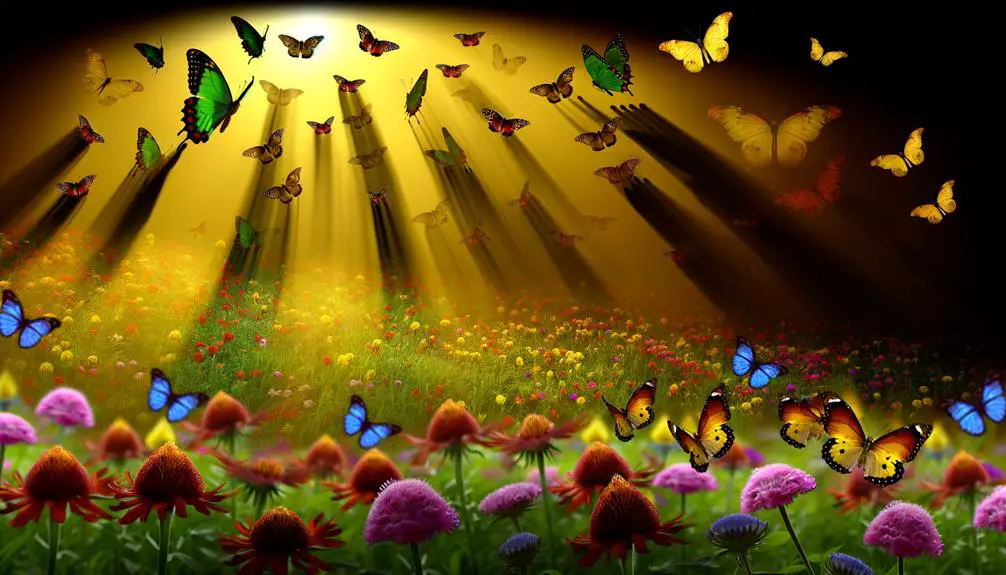
The photoperiod, or length of daylight, plays a significant role in regulating the emergence and activity patterns of butterflies. As day length increases with the approach of spring and summer, it triggers physiological changes in butterflies, such as reproductive development and migration behaviors. Research indicates that many butterfly species use photoperiod cues to time their lifecycle events effectively (Goehring & Oberhauser, 2002). The photoperiod influences hormonal changes, signaling the end of diapause, a period of suspended development, and initiating active phases.
| Day Length | Butterfly Activity | Emotional Impact |
|---|---|---|
| Short | Diapause | Anticipation |
| Lengthening | Emergence | Excitement |
| Ideal | Peak Activity | Joy |
| Shortening | Migration/Diapause | Melancholy |
Understanding photoperiod impacts is essential for conservation efforts and predicting butterfly population dynamics.
Spring Emergence
As temperatures rise and daylight hours extend, the first signs of spring herald the emergence of butterflies from their overwintering states. Species such as the Mourning Cloak (Nymphalis antiopa) and the Eastern Comma (Polygonia comma) are among the earliest to appear, often seen fluttering by late March.
Overwintering strategies include diapause in adult, pupal, or larval forms, triggered by photoperiod and temperature cues (Williams, 1950). Upon emergence, these butterflies actively seek nectar sources and mates to commence the reproductive cycle.
Observations indicate that microhabitat conditions greatly influence emergence timing, with sheltered areas providing ideal thermal microclimates. Understanding these dynamics is essential for conservation efforts, particularly in the face of climate change (Hellmann et al., 2008).
Summer Activity
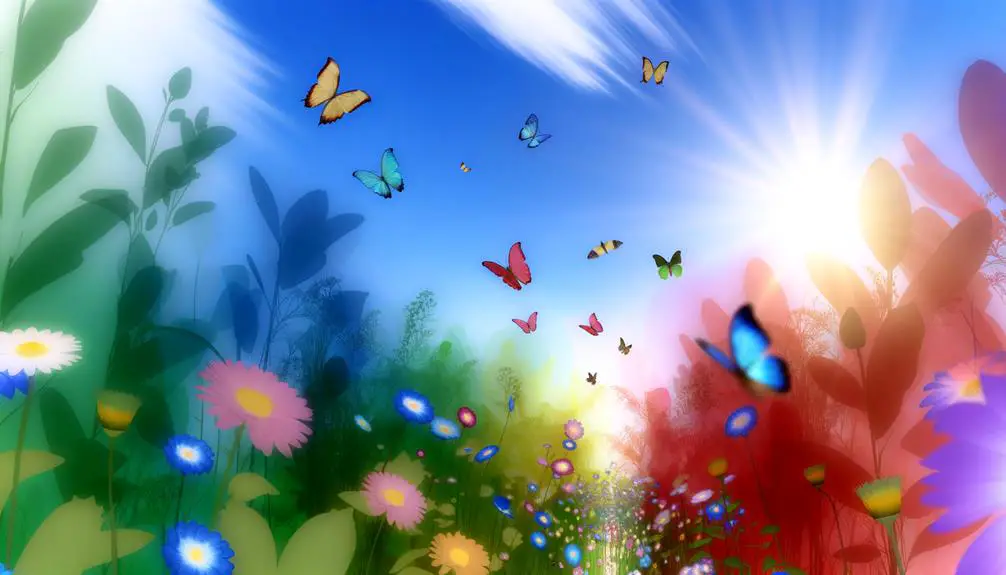
During the height of summer, butterflies exhibit peak activity levels, engaging in behaviors such as territorial defense, mating, and intensified foraging to support their energy needs (Boggs & Freeman, 2005). The increased daylight and warmer temperatures provide ideal conditions for these activities.
Significantly, butterflies demonstrate:
- Territorial Defense: Males actively patrol and defend territories to attract females and deter rivals (Kemp, 2000).
- Mating Strategies: Courtship behaviors become more frequent, with elaborate displays and pheromone signaling (Rutowski, 1991).
- Foraging Activity: Butterflies increase nectar feeding to fuel their heightened metabolic demands and reproductive efforts (Gilbert, 1984).
These behaviors are essential for ensuring reproductive success and survival during the energetically demanding summer months.
Fall Patterns
With the onset of fall, butterfly behavior undergoes notable changes, characterized by decreased activity, migratory movements, and preparation for overwintering (Williams & Bowers, 1991).
Many species, such as the Monarch butterfly (Danaus plexippus), commence long-distance migrations to warmer climates, a phenomenon meticulously documented by Brower (1995).
Concurrently, non-migratory species enter diapause, a state of suspended development to endure winter conditions (Danks, 1987).
This period also sees significant physiological adaptations, including the accumulation of lipids for energy reserves (Pullin, 1992).
Observations reveal reduced feeding activity as butterflies shift focus from nectar sources to locating suitable overwintering sites (Gibbs & Van Dyck, 2010).
These behavioral adaptations are critical for survival, influencing population dynamics and subsequent spring emergence.
Regional Variations
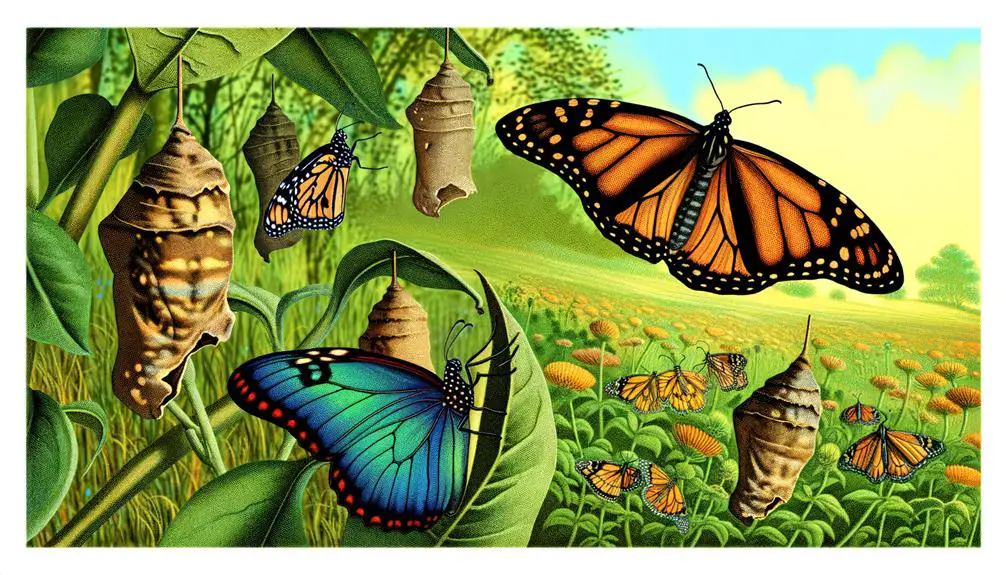
Regional variations considerably influence the timing of butterfly emergence, primarily driven by climatic factors such as temperature and precipitation (Hodgson et al., 2011).
Migration patterns vary by region, with species like the Monarch butterfly undertaking extensive migrations to exploit seasonal resources (Brower et al., 2006).
Consequently, the seasonal appearance of butterflies exhibits marked differences, with some species emerging earlier in warmer southern regions compared to their northern counterparts (Roy & Sparks, 2000).
Climate Influence on Emergence
Variations in regional climate considerably influence the emergence patterns of butterflies, with research indicating that temperature and precipitation regimes play critical roles.
Studies have shown that:
- Temperature: Warmer temperatures accelerate developmental stages, leading to earlier emergence (Walther et al., 2002).
- Precipitation: Adequate rainfall is essential for the availability of host plants, which directly affects larval survival and adult emergence (Bale et al., 2002).
- Seasonal Variability: Regions with distinct seasons exhibit synchronized emergence patterns, while tropical regions show more continuous emergence due to stable climates (Roy & Sparks, 2000).
These climatic factors collectively determine the phenology of butterflies, thereby influencing their lifecycle events.
Understanding these mechanisms is essential for predicting changes in butterfly populations in response to climate change. Researchers are uncovering how factors like temperature shifts and habitat loss impact survival and migration patterns. Studying butterflies and winter secrets can reveal crucial insights into how these insects endure colder months and adapt to evolving environmental conditions.
Migration Patterns by Region
Butterfly migration patterns vary considerably across regions, influenced by a combination of environmental factors, genetic predispositions, and ecological interactions (Dingle & Drake, 2007).
For instance, the Monarch butterfly (Danaus plexippus) exhibits a well-documented, long-distance migration from North America to central Mexico, driven by photoperiod and temperature changes (Brower et al., 2011).
Conversely, the Painted Lady (Vanessa cardui) displays a more irregular, opportunistic migration across Europe, Africa, and Asia, often dictated by local climatic conditions and resource availability (Stefanescu et al., 2007).
Additionally, the Red Admiral (Vanessa atalanta) migrates northward in spring and southward in autumn within Europe, adapting to seasonal variations in habitat (Sparks et al., 2007).
Understanding these regional variances is essential for conservation efforts.
Seasonal Appearance Differences
While migration patterns provide insights into butterfly movements, the timing of their seasonal appearances across different regions further elucidates their ecological adaptations.
Butterfly emergence is influenced by several factors:
- Latitude: Northern regions experience later emergences due to prolonged winters, whereas southern locales see butterflies earlier in the spring (Bale et al., 2002).
- Elevation: Higher altitudes delay developmental stages, resulting in later appearances compared to lower elevations (Hodkinson, 2005).
- Microclimates: Localized climatic conditions create varied emergence times even within the same geographic area (Dennis, 1993).
These factors are essential for understanding butterfly phenology, as they highlight the intricate relationship between environmental variables and life cycle events.
Species-Specific Timings
Each butterfly species exhibits unique emergence patterns influenced by their specific life cycles and environmental conditions. For instance, the Monarch butterfly (Danaus plexippus) typically emerges in late spring, driven by temperature and day length (Brower, 1995). In contrast, the Painted Lady (Vanessa cardui) is known for its multiple broods, emerging from spring through late summer (Stefanescu et al., 2007). The Mourning Cloak (Nymphalis antiopa) often emerges in early spring, having overwintered as adults (Wiklund et al., 1983).
| Species | Typical Emergence Time | Key Environmental Trigger |
|---|---|---|
| Monarch | Late Spring | Temperature, Day Length |
| Painted Lady | Spring to Late Summer | Multiple Broods |
| Mourning Cloak | Early Spring | Overwintering as Adults |
These patterns underscore the diversity within Lepidoptera, each species finely tuned to its ecological niche.
Supporting Butterfly Habitats
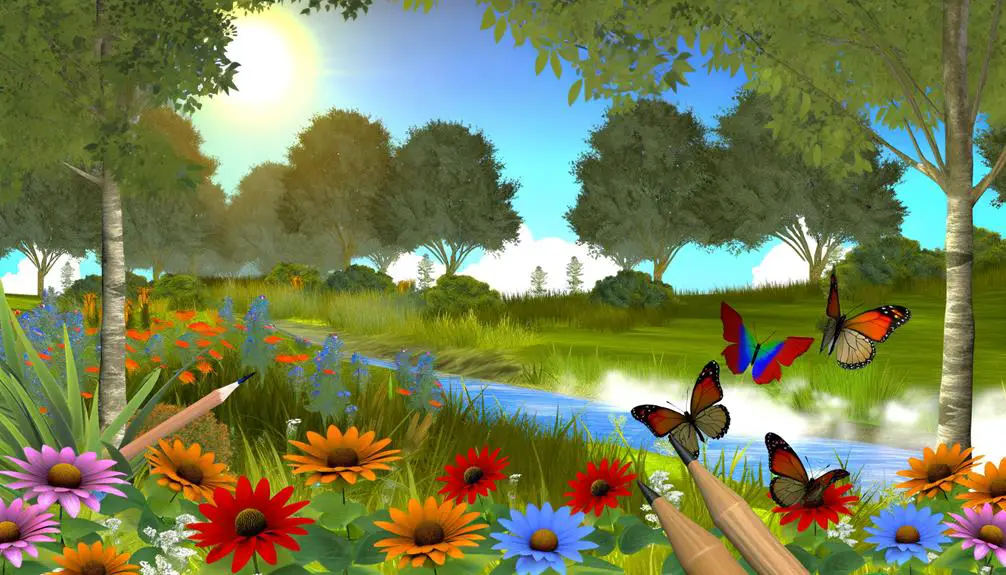
Understanding the specific emergence patterns of butterflies highlights the importance of creating and maintaining habitats that support their life cycles and ecological needs. By preserving native plants and ensuring a stable environment, we can help sustain butterfly populations and promote biodiversity. Additionally, learning about their behavior can be as engaging as exploring butterfly-related activities, such as understanding how many butterflies game rules to enhance awareness and appreciation for these delicate creatures.
Effective butterfly habitats should include:
- Diverse native plants: Native plants offer essential nectar sources and host plants for caterpillars (New, 1991).
- Pesticide-free environments: Chemicals can devastate butterfly populations by disrupting their reproductive cycles (Pimentel, 2005).
- Microhabitats: Varied structures such as rocks, logs, and water sources provide necessary shelter and hydration (Boggs & Murphy, 1997).
These elements are vital for sustaining butterfly populations and ensuring their ecological roles as pollinators and prey.
Research indicates that such habitats greatly enhance butterfly survival rates and biodiversity (Thomas et al., 2001).
As a result, habitat conservation and management are imperative for butterfly conservation efforts.
Conclusion
In conclusion, the emergence of butterflies is a complex interplay of life cycle stages, temperature, and photoperiod, with distinct seasonal patterns observed.
Spring heralds their arrival, summer witnesses peak activity, and fall marks a decline, all influenced by regional and species-specific variations.
Supporting habitats that cater to these parameters is essential for their survival.
As the seasons change, so too do the rhythms of butterfly activity, akin to a meticulously choreographed ballet, underscoring the importance of environmental stewardship.



